|

Unique Oriental Rugs offers carpets woven by the most professional
rug weavers of Iran , India , Afghanistan , Azarbaejan , Pakistan
, China and Turkey. All natural dyes and handspun wool and silk.
Persian rugs are generally made by hand by skilled people. The
craft varies from region to region depending on the environment and
lifestyle of the rug makers. There are still tribal, nomadic, and
rural carpets being made today the same way as they have been thoughout
the ages.
Rugs that are hand knotted do not lose their value. They are known
to gain in value with age. Synthetics usually lose all their resale
value once they are bought. As an investment, a Persian rug is considered
"property with cash value" - similar to gold, gems, and
jewlery. Rugs increase in value with age.
When a business purchases a rug it can be considered a business
expense like purchasing a desk and it also depreciates and can be
deducted accordingly. When rugs are purchased for personal use they
are not taxed as a business gain like other investments.
Following are the most popular design with a brief description
of them. Each design can be viewed by selecting the thumbnail of
that design.
Most popular design
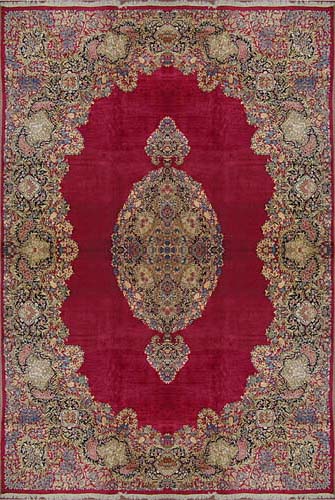 Kerman:
Kerman rugs originated in the southern Persian city of that
name. This rug-making region has been considered as the primary
source of the world's most beautiful and inventive rug designs.
Kermans are worked in harmonious colors, with naturalistic flowers
and chiefly roses. Kerman:
Kerman rugs originated in the southern Persian city of that
name. This rug-making region has been considered as the primary
source of the world's most beautiful and inventive rug designs.
Kermans are worked in harmonious colors, with naturalistic flowers
and chiefly roses.
Carpets from KERMAN have been appreciated by western collectors
for many years. They are particularly famous for having a single
medallion. There are, however, many different designs in KERMAN
carpets and rugs. Another common famous design is the "Tree
of Life."
KERMAN carpets and rugs are of very high quality, just as TABRIZ
and ISFAHAN. Rugs and Carpets from KERMAN have very tight foundations
and the knots are Persian. The quality of the carpet depends upon
the number of knots, which varies, but averages from around 120
KPSI (30 RAJ) up to 842 KPSI (80 RAJ). The reds and blues in KERMAN
rugs and carpets are lighter in comparison with carpets and rugs
made in other cities in IRAN.
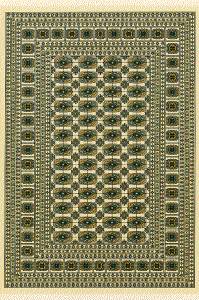 Bokhara:
Bokhara rugs was first woven by Persian nomads and
was named for the city that served as their central point of trade.
Bokhara is one of the numerous designs woven in Pakistan too and
is the most popular and widely known design. The field is filled
with lozenges, octagons, or similar forms which is repeated throughout
the central field and is symbolizes the footprint of an elephant. Bokhara:
Bokhara rugs was first woven by Persian nomads and
was named for the city that served as their central point of trade.
Bokhara is one of the numerous designs woven in Pakistan too and
is the most popular and widely known design. The field is filled
with lozenges, octagons, or similar forms which is repeated throughout
the central field and is symbolizes the footprint of an elephant.
Bokharas are less formal than other Persian designs, and can be
used in dens, and family rooms as well as living and dining areas.
They usually have 200-300 per square inch and comes in 5-8
jewel toned colors with solid color background.
100% wool on a cotton warp and weft. Some rugs will have touches
of silk to outline the design. In addition, some specialty pieces
will be crafted with a large percentage of silk knots.
A 4’x6’ Bokhara can take two and a half months with two
experienced artisans working five hours a day.
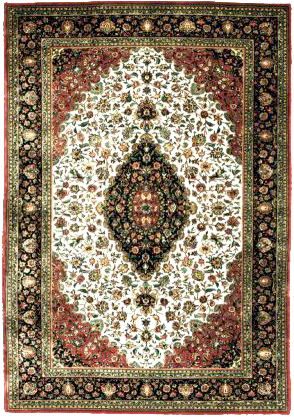 Tabriz: Tabriz is an ancient city in North Western
Iran and it is probably responsible for producing the largest percentage
of all Persian rugs. The weavers of this city were considered to
be among the finest in the world. These rugs have a very short pile,
which makes the drawing stand out with great clarity. The favorite
motif is medallion.
Tabriz: Tabriz is an ancient city in North Western
Iran and it is probably responsible for producing the largest percentage
of all Persian rugs. The weavers of this city were considered to
be among the finest in the world. These rugs have a very short pile,
which makes the drawing stand out with great clarity. The favorite
motif is medallion.
There can be many different unique designs but most of the time
the pattern in a Tabriz rug is filled with dense floral motifs,
with large palmettes, vases, foliage, and small flowers and garden
elements scattered with wild profusion.There can be rugs of this
type with a medallion or without one, and geometric designs are
also seen sometimes.
TABRIZ rugs and carpets are highly prized because they are
one of the best looking carpets in IRAN and the world.
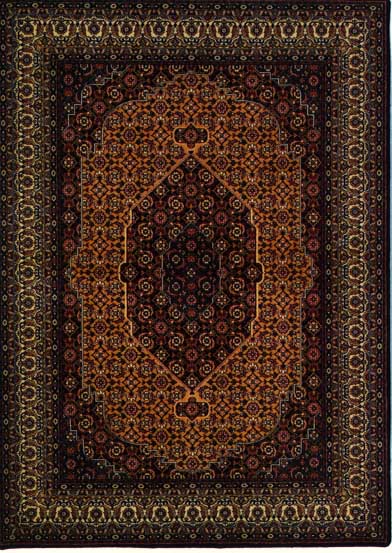 Bijar
: Bijar
is a city in Iran located in northwest of Iran. Bijar rugs are woven
by villagers surroundind the town of Bijar. Carpets from the Bijar
region have always been known for their beauty, intricate design,
and amazing durability.The design of Bijar rugs are geometric and
curvilinear. Medallion designs are common, as are Boteh,
Herati, and minakhani designs in endless repeats often with multiple
borders or guard stripes. Bijar
: Bijar
is a city in Iran located in northwest of Iran. Bijar rugs are woven
by villagers surroundind the town of Bijar. Carpets from the Bijar
region have always been known for their beauty, intricate design,
and amazing durability.The design of Bijar rugs are geometric and
curvilinear. Medallion designs are common, as are Boteh,
Herati, and minakhani designs in endless repeats often with multiple
borders or guard stripes.
Bijar rugs are mostly considered village rugs because whether woven
in the town of Bijar itself or its surrounding villages, they are
woven inside houses rather than workshops. The pattern of Bijar
rugs is a combination of curvilinear and geometric with curvilinear
being dominant. The favorite colors of Bijar weavers consist of
navy, cherry red, brown, light blue, pink, yellow, ocher, orange,
beige and ivory. The symmetrical (Turkish) knot is mainly used although
the asymmetrical (Persian) knot is seen as well.
Bijar carpets are counted among the best Oriental carpets for everyday
use with an extremely tough and rigid handle. Modern Bijar workshop
carpets are still of excellent design and construction.
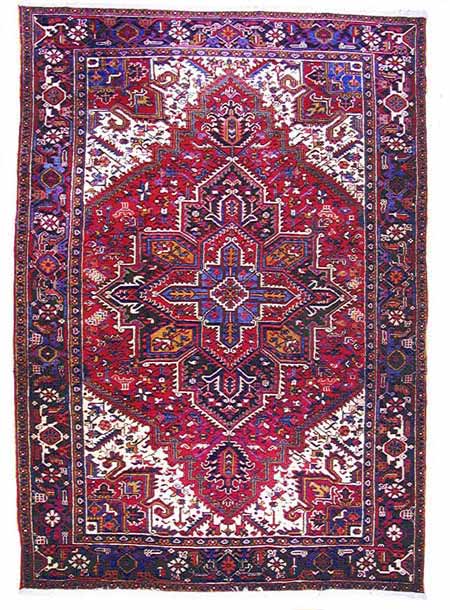 Hariz:
Hariz
rugs originated in the city of Hariz in northwestern Persia. Pattern
in these rugs are of the floral type but translated into near geometric
pattern by the exclusive use of straight lines. Hariz rugs have
basic colors, usually brick or rust reds and also deep blue. The
typical Heriz red and a highly individual medallion are the main
characteristics of these popular carpets. Heriz silk carpets are
exceptionally finely knotted and are both rare and very beautiful.
The designs of old Heriz rugs differ radically from those of new
pieces. The quality is mostly good to very good. It is worth learning
to distinguish the different qualities. Old and antique Heriz carpets
belong to the best carpets on the market. Hariz:
Hariz
rugs originated in the city of Hariz in northwestern Persia. Pattern
in these rugs are of the floral type but translated into near geometric
pattern by the exclusive use of straight lines. Hariz rugs have
basic colors, usually brick or rust reds and also deep blue. The
typical Heriz red and a highly individual medallion are the main
characteristics of these popular carpets. Heriz silk carpets are
exceptionally finely knotted and are both rare and very beautiful.
The designs of old Heriz rugs differ radically from those of new
pieces. The quality is mostly good to very good. It is worth learning
to distinguish the different qualities. Old and antique Heriz carpets
belong to the best carpets on the market.
Colors mostly
the typical dark Heriz red, brown and beige. Blue is used as contrast
and contour colors. New pieces tend to be rather inharmoniously
colored. Old and antique Heriz carpets are sometimes found in large
formats and in wonderful blue and turquoise shades.Center medallions
are often richly decorated and have a characteristic, rather rectangular
shape. Filler motifs include arabesques, palmettos and rosettes
in colorful repeat. Also characteristic are the square or rectangular
corners in the field, often decorated with arabesques.
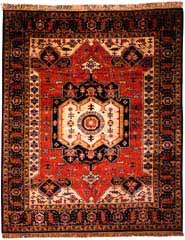
Serapi:
Serapi is a trade name given to better quality versions of Hariz
rugs. Such rugs are sometimes called Serapi Hariz.
In the United States the highest quality of Heriz Carpets are called
Serapi. Quality is higher than the average and knot counts are around
80 knots per square inch with the very best going up to 100 knots
per square inch. Serapis have mellow colors and a less busy field
than a standard Heriz.
The line between a Serapi and an antique Heriz is more a matter
of style than substance. For instance Sotheby's New York does not
generally use the term Serapi while their counterparts in Sotheby's
London regularly use the term. In Germany both Nagel and Rippon
Boswell use the term Serapi.
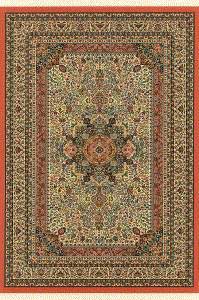 Esfahan:
Esfahan
is located in western central Iran. Esfahan rugs have been and still
remain very famous worldwide. The carpets from Esfahan are very
symmetrical and balanced. These carpets usually have a single medallion
that surround with vines and palm leaves.The turkish knot is used
in these rugs. Esfahan:
Esfahan
is located in western central Iran. Esfahan rugs have been and still
remain very famous worldwide. The carpets from Esfahan are very
symmetrical and balanced. These carpets usually have a single medallion
that surround with vines and palm leaves.The turkish knot is used
in these rugs.
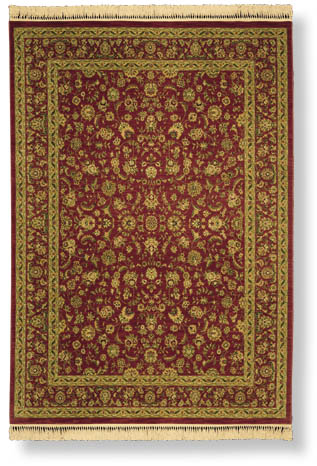 Kashan:
Kashan
is a city in Iran located in north central Iran. The pile in these
rugs is short, the field is either designed around a large medallion
or is an all-over design with the border consisting of delicate
scrolling stems. It is common for these rugs to have a navy medallion
with red background or vise versa. Kashan:
Kashan
is a city in Iran located in north central Iran. The pile in these
rugs is short, the field is either designed around a large medallion
or is an all-over design with the border consisting of delicate
scrolling stems. It is common for these rugs to have a navy medallion
with red background or vise versa.
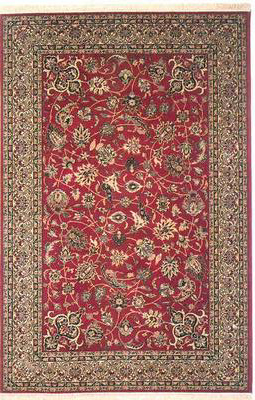 Saruk:
These
rugs come in either all-over design or with medallion. A classic
scrolling design forms the border of these rugs. Saruk:
These
rugs come in either all-over design or with medallion. A classic
scrolling design forms the border of these rugs.
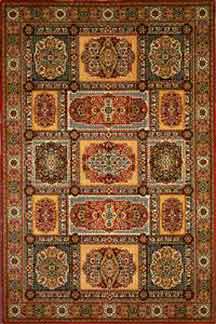 Bakhtiari:
These
rugs are woven in West Central Iran. The pattern in these rugs are
mostly geometric. Panelled design, large medallions, vase, all-over
boteh, and tree of life can also be found in Bakhtiari rugs. Small
rugs, saddlebags and trappings are woven by nomadic Bachtiaris,
while large carpets are woven by the settled tribes people. Bakhtiari:
These
rugs are woven in West Central Iran. The pattern in these rugs are
mostly geometric. Panelled design, large medallions, vase, all-over
boteh, and tree of life can also be found in Bakhtiari rugs. Small
rugs, saddlebags and trappings are woven by nomadic Bachtiaris,
while large carpets are woven by the settled tribes people.
There is great variety of color in the carpets produced in the several
hundred villages of the area. The principal color include many white
and ivory shades, as well as various red and browns, greens and
yellows, but relatively little blue. Natural dyes generally produce
a harmonious range of color.
The most familiar pattern is the garden design consisting of repeated
squares or diamonds, each of which encloses a tree or floral motif.
The name translates roughly as "the lucky ones".
The Turkish knot is used in very varying knot densities, ranging
from very coarse to medium fine.
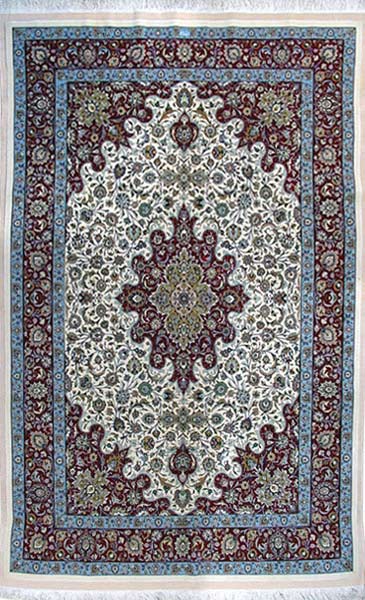 Mashad:
Mashad rugs and carpets are mostly curvilinear with the single
central medallion and corner floral design, and very busy curvilinear
floral motifs in the background. The Mashhad carpets are made of
the wool peculiar to the whole province of Khorassan: Mashad:
Mashad rugs and carpets are mostly curvilinear with the single
central medallion and corner floral design, and very busy curvilinear
floral motifs in the background. The Mashhad carpets are made of
the wool peculiar to the whole province of Khorassan:
very soft and very lustrous, though perhaps rather less hard-wearing
than other Persian wools. Formerly the palm-leaf pattern in various
sizes was much used, as it was for other kinds of Khorassan carpets;
Mashad is known for producing some of the best wool in IRAN. Mashad
rugs and carpets have very high quality. MASHAD carpets are one
of the most great looking carpet in IRAN and the world.
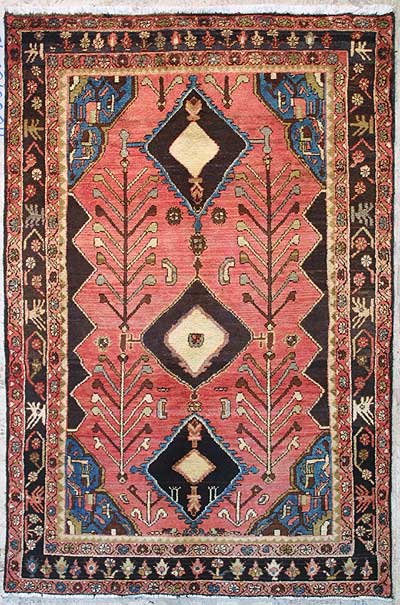 Hamadan
: HAMEDAN is one of the oldest cities of IRAN. HAMEDAN
produces beautiful tribal hand-woven rugs made in the city and the
areas surrounding HAMEDAN in the west of IRAN. Carpets made in HAMEDAN
usually have geometric patterns. HAMEDEN village rugs all have a
single-wefted medallion.Weavers in HAMEDAN use Turkish knots, and
carpets are flat-woven. Hamadan
: HAMEDAN is one of the oldest cities of IRAN. HAMEDAN
produces beautiful tribal hand-woven rugs made in the city and the
areas surrounding HAMEDAN in the west of IRAN. Carpets made in HAMEDAN
usually have geometric patterns. HAMEDEN village rugs all have a
single-wefted medallion.Weavers in HAMEDAN use Turkish knots, and
carpets are flat-woven.
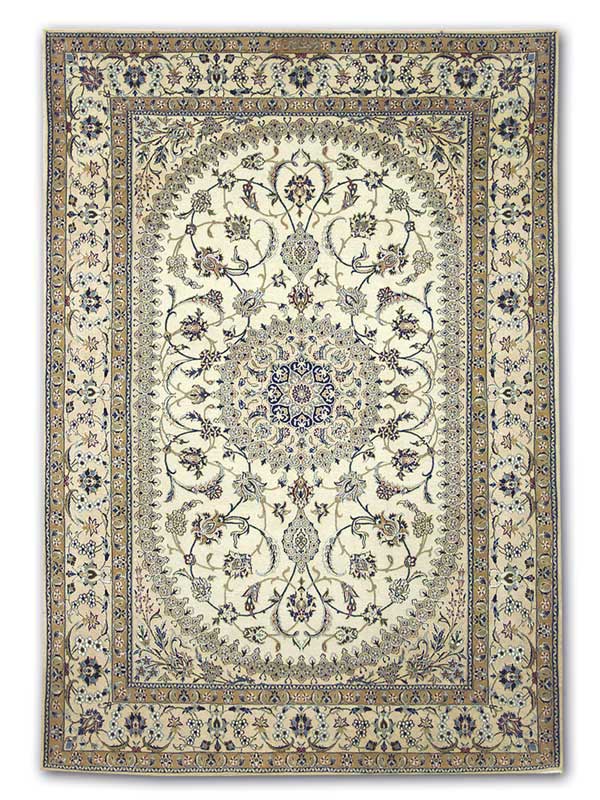 Nain
: Nain rugs take their name after the Persian city
of Nain. The city of Nain began producing fine carpets sometime
around 1940. Nain carpets are characterized by ivory fields, with
blues, browns, and tans to create an intricate design. Finer Nain
carpets can be woven at 600 or more knots per inch, with silk inlay. Nain
: Nain rugs take their name after the Persian city
of Nain. The city of Nain began producing fine carpets sometime
around 1940. Nain carpets are characterized by ivory fields, with
blues, browns, and tans to create an intricate design. Finer Nain
carpets can be woven at 600 or more knots per inch, with silk inlay.
Nain rugs are almost exclusively made with silk and wool piles on
cotton bases, however, with the silk in the majority of Nain rugs
used to outline the patterns and motifs through the rugs. In addition,
the coloring of Nain rugs have blue and ivory schemes.
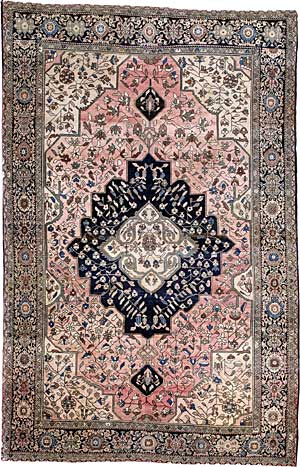 Farahan:
Farahan is a village located in the province of Markazi in
central Iran. Older Farahan rugs are very popular in the West. Most
Farahan rugs have a geometric pattern although some curvilinear
rugs are woven in Farahan as well. These high quality rugs are mainly
woven by the asymmetrical knot on cotton foundation. Farahan:
Farahan is a village located in the province of Markazi in
central Iran. Older Farahan rugs are very popular in the West. Most
Farahan rugs have a geometric pattern although some curvilinear
rugs are woven in Farahan as well. These high quality rugs are mainly
woven by the asymmetrical knot on cotton foundation.
 Baluch
: Baluch are large group of nomadic tribespeople living in
Afghanistan and eastern Iran who weave many types of small rugs,
animal trappings and tent furnishings. They favor deep tones of
blue, dark brown, dark red and touches of natural ivory. Baluchi
rugs are mainly geometric. The Blauchi tree-of-life prayer rug is
the most well known of all Baluchi designs. Other designs include
repeating all-overs with floral motifs or repeating all-overs with
abstract living creatures such as animals (birds are common) and
humans. The main colors used in Baluchi rugs are red, dark blue,
camel, beige and white. A common border design is a zigzag design.
Baluchi rugs are generally made in small sizes. Baluch
: Baluch are large group of nomadic tribespeople living in
Afghanistan and eastern Iran who weave many types of small rugs,
animal trappings and tent furnishings. They favor deep tones of
blue, dark brown, dark red and touches of natural ivory. Baluchi
rugs are mainly geometric. The Blauchi tree-of-life prayer rug is
the most well known of all Baluchi designs. Other designs include
repeating all-overs with floral motifs or repeating all-overs with
abstract living creatures such as animals (birds are common) and
humans. The main colors used in Baluchi rugs are red, dark blue,
camel, beige and white. A common border design is a zigzag design.
Baluchi rugs are generally made in small sizes.
email: info@uniquerug.com
home | about rugs | hand-knotted
| hand-tufted | machine-made
| rugs pad | cleaning
& care | restoration | designer
discount | specials | contact
|











 Mashad:
Mashad rugs and carpets are mostly curvilinear with the single
central medallion and corner floral design, and very busy curvilinear
floral motifs in the background. The Mashhad carpets are made of
the wool peculiar to the whole province of Khorassan:
Mashad:
Mashad rugs and carpets are mostly curvilinear with the single
central medallion and corner floral design, and very busy curvilinear
floral motifs in the background. The Mashhad carpets are made of
the wool peculiar to the whole province of Khorassan:


 Baluch
: Baluch are large group of nomadic tribespeople living in
Afghanistan and eastern Iran who weave many types of small rugs,
animal trappings and tent furnishings. They favor deep tones of
blue, dark brown, dark red and touches of natural ivory. Baluchi
rugs are mainly geometric. The Blauchi tree-of-life prayer rug is
the most well known of all Baluchi designs. Other designs include
repeating all-overs with floral motifs or repeating all-overs with
abstract living creatures such as animals (birds are common) and
humans. The main colors used in Baluchi rugs are red, dark blue,
camel, beige and white. A common border design is a zigzag design.
Baluchi rugs are generally made in small sizes.
Baluch
: Baluch are large group of nomadic tribespeople living in
Afghanistan and eastern Iran who weave many types of small rugs,
animal trappings and tent furnishings. They favor deep tones of
blue, dark brown, dark red and touches of natural ivory. Baluchi
rugs are mainly geometric. The Blauchi tree-of-life prayer rug is
the most well known of all Baluchi designs. Other designs include
repeating all-overs with floral motifs or repeating all-overs with
abstract living creatures such as animals (birds are common) and
humans. The main colors used in Baluchi rugs are red, dark blue,
camel, beige and white. A common border design is a zigzag design.
Baluchi rugs are generally made in small sizes.